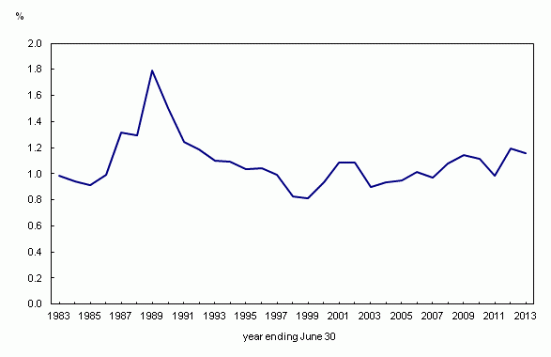On July 1, 2013, Canada’s population was at 35,158,300, according to the government data agency Statistics Canada.
That was an increase of 1.2% over the estimate of 2012. And, except for the period between 1986 and 1990, the population growth rate has shown little variation in 30 years, ranging from 0.8% to 1.2%.

Demographic growth rate, Canada, year ending June 30, 1983 to 2013. (Graph: Statistics Canada)
For the year ending June 30, 2013, population growth was lower in the Atlantic provinces and negative in Nova Scotia (-0.5%), while generally higher in the western provinces. Population growth exceeded the national level (+1.2%) in the western province of Alberta (+3.4%), the northern territory of Nunavut (+2.5%) and the western province of Saskatchewan (+1.9%).
In the last 30 years, the populations of the western prairie provinces and the Pacific coast province of British Columbia combined have grown substantially (+39.5%), while the Atlantic provinces have seen their populations edge up 3.5%.
The population of Canada’s most populous province Ontario (13,537,994) grew almost twice as rapidly (+39.8%) as that of of the second most populous province, the predominantly French-speaking province of Quebec (8,155,334) (+21.0%) during this period.
More information:
Statistics Canada – Canada’s total population estimates, 2013 – here







For reasons beyond our control, and for an undetermined period of time, our comment section is now closed. However, our social networks remain open to your contributions.